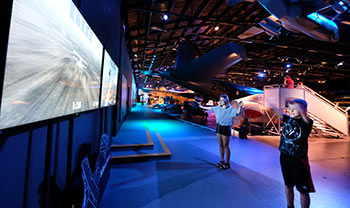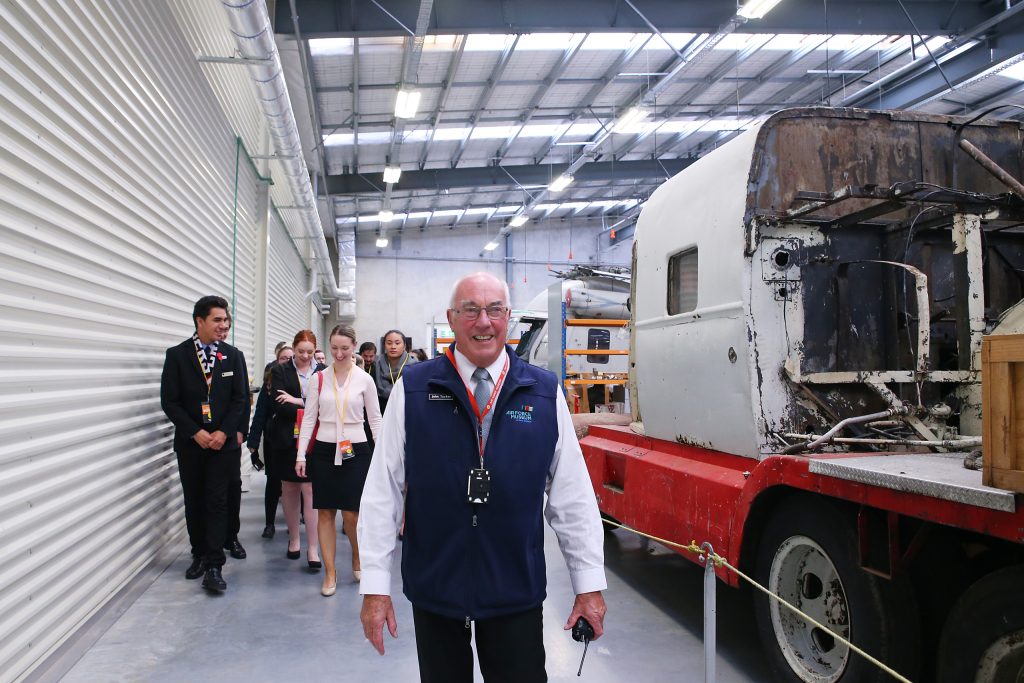Heraldry is serious business! So serious in fact that the RNZAF has a lengthy approval process that involves the Queen herself.
When a new badge (commonly referred to as a ‘crest’) is proposed for a squadron or unit, the design is submitted to the Chief of Air Force (CAF) with an explanation of the symbolism, a translation of the motto from a learned authority, and three physical copies. Once it has been approved by CAF it is then forwarded to the College of Arms in London who prepare a copy to be presented to the reining Sovereign. Only once a design passes this final hurdle is it deemed to be official.
Although all RNZAF badges are framed with a standard template consisting of fern leaves and crown, a lot of thought goes into the symbolism of the motto and central badge design. It must capture the essence, values or focus of a unit while being distinct and identifiable. Aotearoa has a unique position, in terms of heraldry, of being able to draw inspiration from Māori culture, to create designs that are undoubtedly and recognisably ‘New Zealand’.
The most obvious is the use of Te Reo Māori, one of our three official languages. The RNZAF has a long tradition of incorporating Te Reo into badge mottos. So, to help celebrate Te Wiki o te Reo Māori – Māori Language Week – we thought we would share some of these with you. Scroll down to discover some badges from past and present RNZAF units, and the translation and explanation of their Te Reo mottoes.
No. 486 (NZ) Squadron RAF
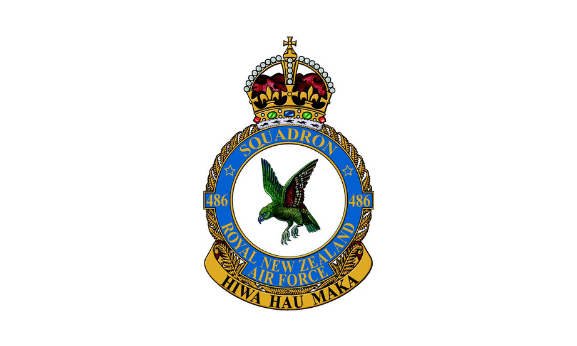
The motto of No. 486 Squadron, “Hiwa Hau Maka”, and the badge bearing a kea volant (in flight) were chosen to reflect the Squadron’s fighting spirit. The kea (New Zealand native alpine parrot) is described as “a powerful, crafty and fearless bird of prey” in the official orders. The motto translates as “Beware the wild winds”, a statement made more intimidating when coupled with the Hurricane fighter aircraft that the Squadron first flew. 486 Squadron was also later equipped with Typhoons and Tempests towards the end of World War Two in keeping with its stormy motto.
No. 487 (NZ) Squadron RAF
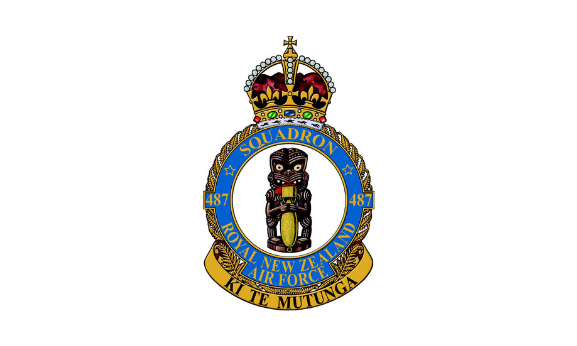
No. 487 Squadron was initially formed as a day bomber squadron, which explains the tekoteko (carved human form) holding a bomb in the centre of their badge. 487 Squadron took part in Operation Ramrod 16, a raid on a power station in German-occupied Amsterdam, on 3 May 1943. Living up to their motto “Ki Te Mutunga” (“Through to the end”), the crews continued to fly through heavy enemy resistance, suffering tremendous casualties, to reach the target. Only one aircraft, piloted by Squadron Leader Leonard Trent, managed to drop its load over the target before being shot down shortly after. For his “cool unflinching courage and devotion to duty in the face of overwhelming odds” he was awarded the Victoria Cross.
No. 488 (NZ) Squadron RAF
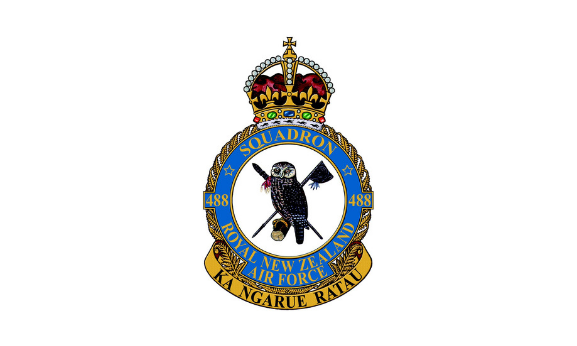
When No. 488 Squadron was reformed following its service in the Battle of Singapore in 1942, it took on a new combat role. Equipped with Beaufighters, the Squadron engaged in ‘intruder’ operations, penetrating deep behind enemy lines under the cover of night. What better symbol for the badge, then, than the morepork, New Zealand’s native nocturnal bird of prey? The motto “Ka Ngarue Ratau” translates as “We shake them”, reflecting the effect of the heavy weaponry the Beaufighters were equipped with.
No. 490 (NZ) Squadron RAF
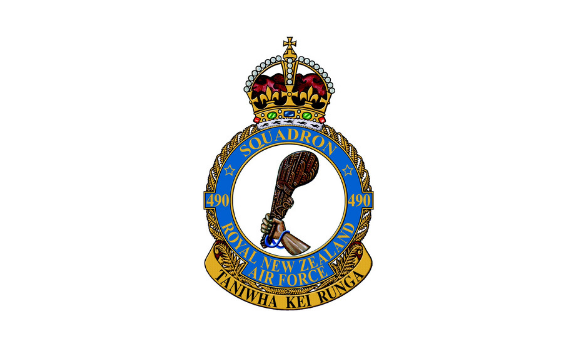
“Taniwha Kei Runga”! With a taniwha being a supernatural creature that customarily lives in deep pools, rivers, or the sea, some may think that it would be better suited to a Navy motto. No. 490 Squadron’s reference to a taniwha, however, creates a vivid picture of its role and aircraft. Translating as “The taniwha is in the air” it conjures images of the large, and some might say monstrous, Catalina and Sunderland flying boats operated by the Squadron, bouncing along the water before finally roaring into the skies.
No. 40 Squadron RNZAF

No. 40 Squadron forms the Fixed Wing Transport Force for New Zealand and its role takes it all over the globe. The Squadron provides humanitarian aid and disaster relief, medical evacuations, civil defence support and VIP transport as well as support for military operations in places as wide-ranging as the Middle East, Africa and Antarctica, while also operating within New Zealand and with our Pacific neighbours. The Squadron truly lives up to its motto “Ki Nga Hau E Wha” (“To the four winds”), with the compass emblem an appropriate centrepiece of the badge.
No. 14 Squadron RNZAF
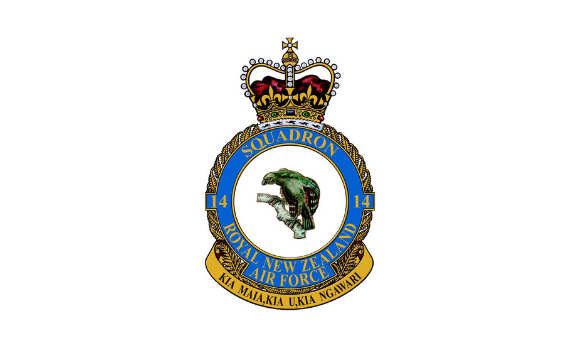
When this badge was originally proposed, it was supposed to feature a kaka (New Zealand native forest parrot), but the artist at the College of Arms in London mistakenly drew instead its cousin, the kea. The badge was approved, and the kea was proudly adopted by No. 14 Squadron, making it the only bird to feature twice in RNZAF heraldry (see 486 Squadron, above). The motto, “Kia Maia, Kia u, Ngawari” translating as “Active, Ardent, Adaptable”, was chosen to reflect the “fearless and aggressive qualities proper to a fighter squadron”.
Central Flying School RNZAF
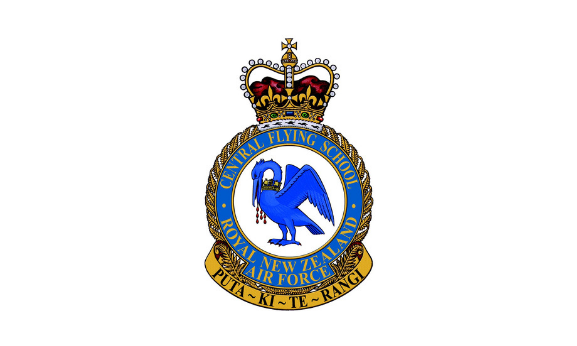
The badge of the Central Flying School (CFS) features a pelican with Naval Crown collar wounding itself. This design alludes to the association between the RNZAF Central Flying School and the RAF Central Flying School (whose badge features similar imagery), an affiliation that was approved by Her Majesty the Queen back in 1957. CFS is responsible for training the NZDF’s flying instructors and also provides pilots for the RNZAF’S aerobatic display team, The ‘Black Falcons’. Their motto, “Puta Ki Te Rangi”, translating as “Come forth to the sky”, reflects the School’s focus on producing highly skilled flying instructors.
No. 2 Technical Training School RNZAF
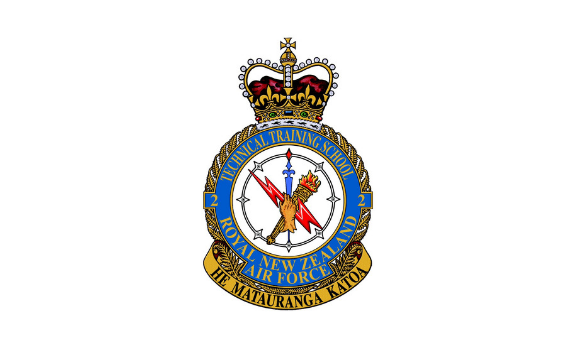
An adaptation of the earlier Electrical and Wireless School badge, No. 2 Technical Training School’s badge indicates the School’s focus on specialised trade training. The torch represents learning, while the lightning bolt and compass in the background represent the electrical, communications and instrument trades. The motto “He Matauranga Katoa”, “All things are possible through understanding and knowledge”, reflects the virtues that the School instilled in its trainees.
Music Services

Although not an official badge, this was approved for use on blazers and for presentations in the 1970s. Based on the badge worn by RNZAF Band members, it features a lyre superimposed over a book of music, the lyre being the classical representation of music in general. The motto “Te Waiata O Ngatoa” reflects the military nature of Air Force Music Services, translating as “the music of the warriors”.

